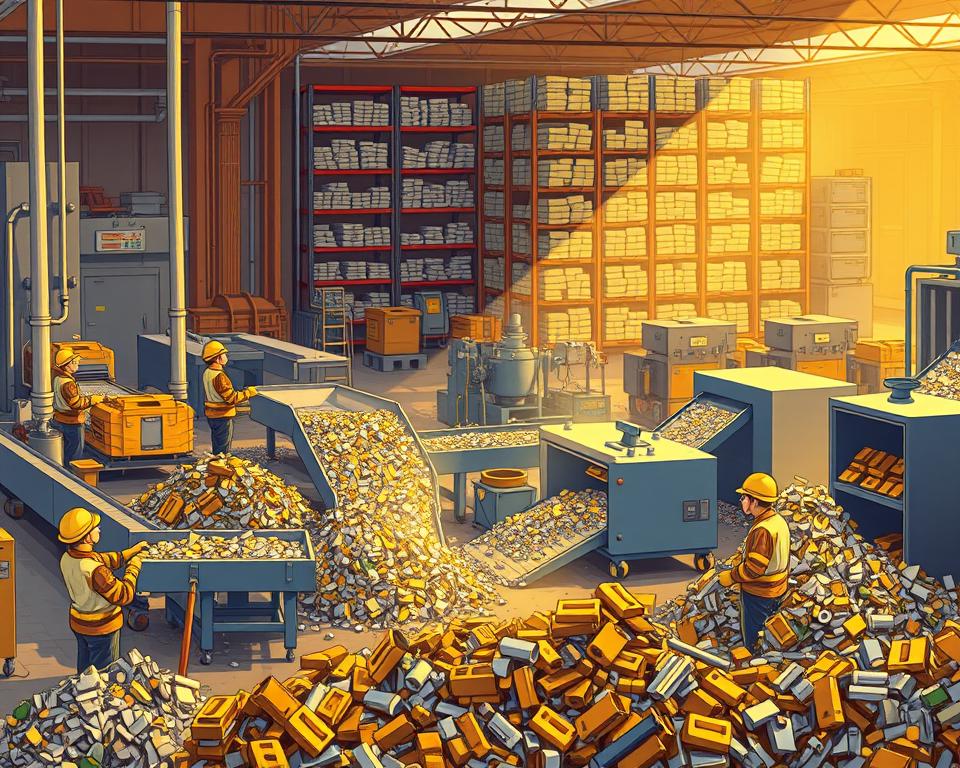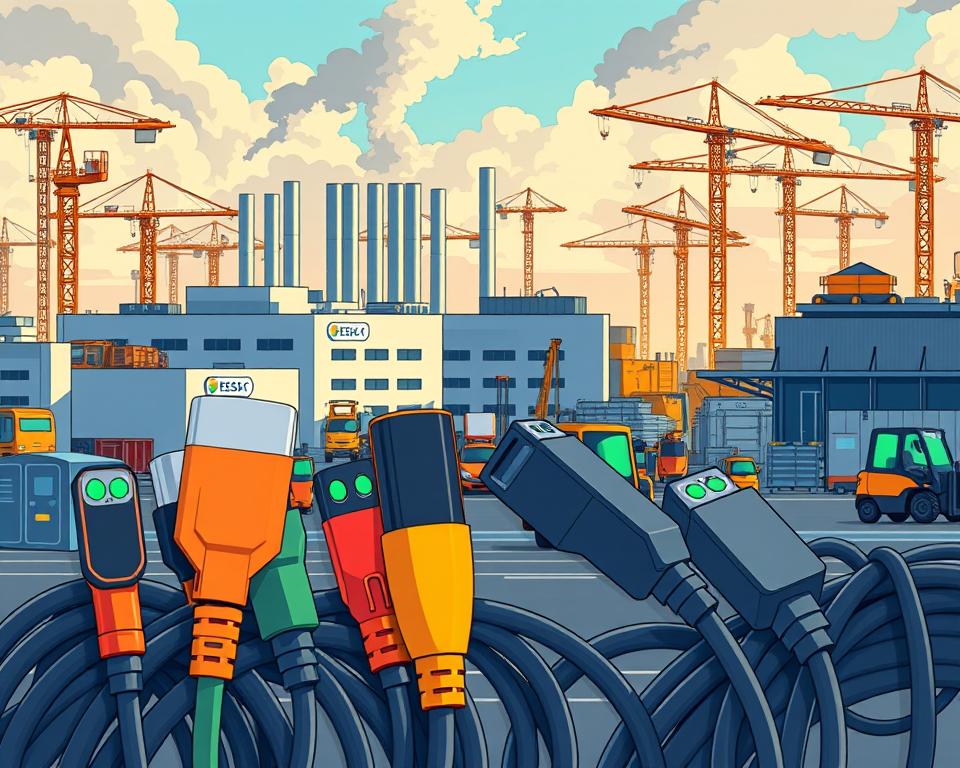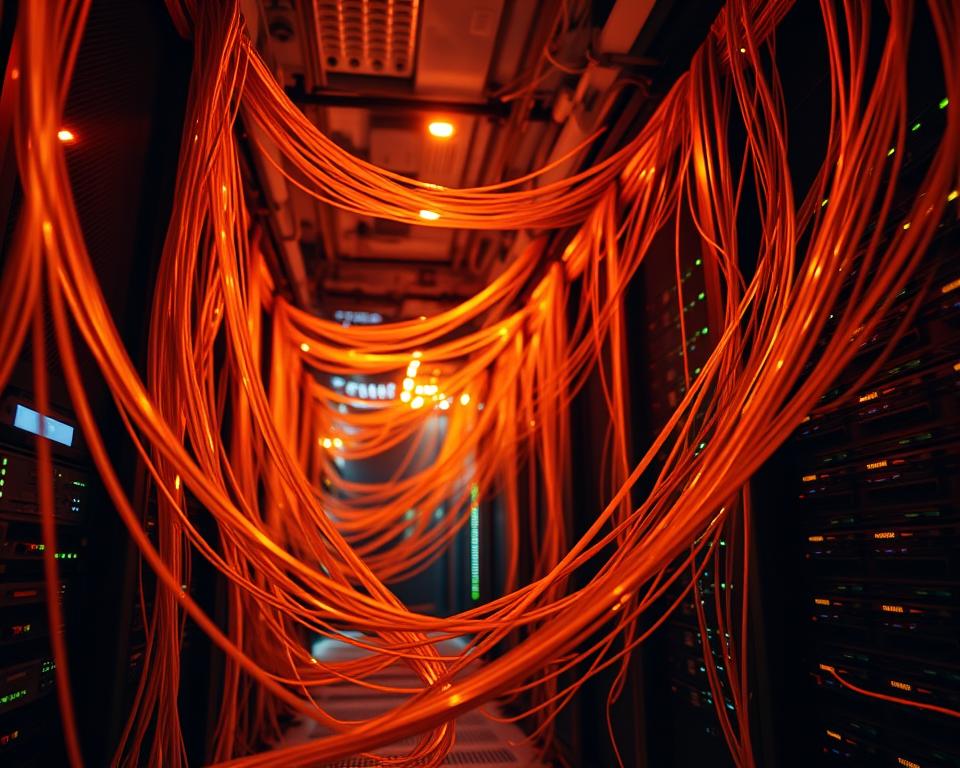Your Guide to Green Precious Metal Recovery
Did you know that more than $60 billion worth of precious metals are discarded each year in electronic waste alone? This staggering figure underlines the critical role of precious metal recycling. It’s not just good for our economy but also for the environment. Reclaiming gold, silver, platinum, and palladium helps lower pollution and preserve what’s left of our natural resources.
Companies like Dongsheng Metal Trading are leading the charge towards sustainability. They guarantee that valuable metals return to use instead of filling dumps. Such a precious metals recycling model drives eco-friendly recycling and sustainable methods.
Top Highlights
- Each year, e-waste discards over $60 billion in precious metals.
- Precious metal recycling reduces environmental impact and conserves resources.
- Gold, silver, platinum, and palladium top the list of valuable metals.
- Eco-friendly recycling practices are vital for sustainable development.
- Companies like Dongsheng Metal Trading specialize in metal recycling.
Exploring Precious Metals and Their Worth
Rare metallic elements known as precious metals attract both investors and manufacturers. Gold, silver, platinum, and palladium are prime examples, known for their unique properties. These include electrical conductivity, corrosion resistance, and substantial rarity. Extracting and refining them uses up huge resources, so recycling becomes critical.

The value of precious metals is influenced by market demand and the inherent qualities of each metal. Metal recycling ensures the supply chain remains robust. It also reduces environmental impacts associated with mining activities. Through exhaustive recycling processes, these metals can be restored to their original state. That process conserves scarce materials and boosts the economy.
Precious Metals Explained
Unique features make precious metals ideal for many uses. Their rarity and intrinsic properties are foundational to their economic significance. Notable examples are:
- Gold: Valued for its beauty and resistance to tarnish.
- Ag: Celebrated for its adaptability and conductivity.
- Platinum: Celebrated for its durability and catalytic properties.
- Palladium: On the rise in automotive and tech industries.
Reasons to Recycle Precious Metals
Recycling these metals is now key to sustainable practices. It saves scarce materials and sharply cuts mining’s eco-footprint. Consider these advantages:
- Reduction of environmental degradation caused by mining operations.
- Energy needs are far lower than mining virgin ore.
- Supporting a circular economy via material reuse.
- Economic upside from extracting high-value resources.
Why Precious Metal Recycling Matters
Recovering metals delivers big eco and financial wins. Highlighting these advantages is key to reducing our ecological footprint. Additionally, it fuels market growth and resilience.
Environmental Benefits
The environmental benefits of recycling precious metals are significant. By reclaiming metals from discarded electronics and industrial scrap, we cut down on landfill waste. It curbs mining demand and preserves nature.
It lessens mining impacts, including ecosystem harm and contaminants. By prioritizing recycling, we work toward a greener tomorrow.
Financial Gains
The economic benefits of recycling are equally compelling. Using reclaimed metals trims manufacturing budgets. This allows industries to use reclaimed metals instead of new ones.
It produces recycling-sector employment and strengthens markets with growing recycled-metal needs. Using these financial benefits, companies can improve profits. They further support a cleaner economy.
Steps in Metal Recycling
Metal recycling demands a multi-stage process to optimize recovery. First, scrap electronics, jewelry, and industrial waste are gathered. They are sorted, decontaminated, and analyzed to gauge composition and value.
Recycling Workflow
A structured workflow is key to high-yield recovery. Each step is designed to optimize the yield of precious metals. Metals are sorted according to their type and purity. Decontamination eliminates residues that block recovery. Testing measures metal content to select proper recycling methods.
Recovery Methods
Advanced recycling techniques are employed to achieve high metal recovery rates. Thermal reduction, using high temperatures to separate metals from ores, is a key method. Smelting and chemical baths extract and purify metals. Companies like Dongsheng Metal Trading use these methods to boost efficiency and maximize returns in the precious metal recycling process.
Which Precious Metals Are Recyclable
Scrap recovery benefits both Earth and economy. A host of precious metals are recyclable, aiding markets and ecosystems. Awareness of recyclable metals guides consumers and companies.
Recycling Gold, Silver & Platinum
Gold, silver, and platinum stand out among precious metals. You’ll see them in rings, currency, and industrial parts. Gold recovery is widespread because of its worth and need. Silver recycling is also key, used in photography, electronics, and solar panels.
Platinum, while rarer, finds value in catalytic converters.
Rare Metals in Electronics
E-waste metals present special recovery opportunities. Devices such as phones and computers hold palladium and indium. Recovering such metals diminishes e-waste and yields vital materials.
Recycling these electronics metals is imperative. Businesses work to reduce scrap and upscale resource recovery.
Who Gains from Metal Recycling?
Recycling precious metals supports industries by providing efficient, green resource supply. Electronics, which embeds metals in gadgets, gains the most. Aerospace and healthcare rely on them for vital parts. Exploring how these industries recycle precious metals reveals the environmental and economic benefits.
Electronics Industry
The electronics industry leads in precious metal recycling due to the abundance of valuable metals in devices like smartphones and computers. Rapid technological advancements have led to a significant increase in electronic waste. Thus, recycling gold, silver, and palladium efficiently becomes vital. It not only conserves natural resources but also reduces mining-related carbon emissions.
Companies are increasingly focusing on recycling to meet global sustainability and waste reduction goals. That change bolsters resource saving and ecosafety.
Aerospace and Medical Equipment
Metal recovery is key in aerospace and medical sectors where metals are in vital parts. Durable, corrosion-resistant alloys are used in aircraft and medical tools. Metal recovery slashes expenses and ensures eco-compliance.
Both industries understand that responsible recycling practices help mitigate resource scarcity. It also enhances operational efficiency, making recycling a key strategy for sustainability.
Selecting Recycling Partners
Locating reliable recycling partners ensures great results. Be sure to quiz them on their methods. Pricing models and processes make a big difference. Reviewing offerings lets you select wisely.
What to Ask a Recycler
- Which recovery certifications does your company have?
- Can you explain your processing methods for different metals?
- What are your recovery rates for various precious metals?
- What is your pricing structure and are there extra charges?
- Can you share feedback from past customers?
Comparing Prices and Services
You must evaluate services side-by-side to pick the right recycler. Use a table to line up these factors:
| Company Name | Recovery Rate (%) | Processing Fee ($) | Turnaround Time (Days) |
|---|---|---|---|
| Recycling Co. A | 95 | 50 | 7 |
| Recycling Co. B | 90 | 45 | 5 |
| Recycling Co. C | 92 | 55 | 10 |
Comparing options ensures you get top value and service. That way, you maximize returns and maintain quality.
Recycling Precious Metals: A Green Guide
Grasping recycler workflows is essential for metal recovery. These experts manage the entire process, from collection to processing. This ensures maximum efficiency and value from metals.
How Recyclers Operate
Advanced workflows—assay, separation, smelting—unlock metal value. First, they gather scrap from multiple origins. Then, they use sophisticated techniques to separate different metals. In the last stage, precious metals are refined to purity.
It optimizes yield while advancing environmental goals. It’s a critical step towards sustainable development.
Selecting Your Ideal Recycler
When picking a recycler, several factors are important. Start with their sustainability track record. A focus on sustainability is non-negotiable. Also, consider the services they offer, from basic collection to full processing.
Cost is equally important. Gather price quotes for side-by-side comparisons. Companies like Dongsheng Metal Trading offer customized solutions for various industries. They are a reliable choice for specific recycling needs.
Pick the Right Facility
Recovery facilities are central to green waste solutions. There are specialized centers for different metals and materials. Knowing the facility landscape helps you connect with the right partner. This benefits both businesses and the environment.
Types of Facilities Available
Metal recycling facilities vary widely in their operations. Some yards recover gold and silver; others accept all metal waste. Common examples include:
- General scrap yards handle both ferrous and non-ferrous materials.
- Specialized firms recover gold, silver, and platinum with advanced refining.
- E-waste hubs target valuable metals inside tech devices.
Choosing Facility Locations
Proximity to recyclers cuts logistical hurdles. Firms need to plan transport logistics. Here are some factors that influence access:
| Factor | Description |
|---|---|
| Proximity | Facilities located nearer to businesses minimize transportation costs and time. |
| Networking | Strong ties with local centers streamline recovery. |
| Services Offered | Knowing each facility’s offerings guides your choice. |
In sum, selecting the right type of recycling center and ensuring convenient access can significantly enhance the efficiency of metal recycling operations.
Electronic Waste Recycling and Precious Metals
Discarded electronics threaten the environment. Discarded devices often contain precious metals that can be recovered through recycling. That underscores viewing e-waste as a metal source.
Electronic Precious Metals
Gadgets harbor small quantities of precious metals. You’ll find them in components such as:
- Circuit boards
- Connectors and ports
- Capacitors and resistors
- Battery terminals
Common electronics conceal recoverable metals. With recycling, we can efficiently recover and reuse them.
The Importance of E-Waste Recycling
Recycling electronics protects nature and recovers resources. That cuts landfill volume and conserves resources. The benefits of recycling e-waste metals are clear:
- It lowers pollution risks tied to discarded electronics
- It reduces CO₂ output via green recycling methods
- It supports the circular economy by recycling materials back into production
Encouraging electronic recycling promotes sustainable resource management. It lays the groundwork for a greener future.
The Future of Precious Metal Recycling
Recycling is changing fast thanks to new tech and eco-driven demand. As the need to conserve resources grows, major players in recycling are adapting. They are embracing new methods and processes, setting the stage for the future of recycling precious metals.
Green Recycling Trends
Modern green recycling strives to cut waste and eco-damage. Firms now use bio-packaging and low-energy methods. Such moves match worldwide green goals and nudge industries to be more eco-responsible.
New Metal Recovery Tech
Advances in recovery techniques are key to improving precious metal recycling efficiency. Robotic sorting and chemical extraction raise recovery. These innovations not only increase resource extraction but also reduce environmental impact, marking a significant step forward in recycling precious metals.
How to Start Your Own Precious Metal Recycling Business
Building a metal recycling enterprise calls for thorough planning and industry knowledge. Entrepreneurs must outline key steps to build a strong foundation and adhere to industry regulations. That means in-depth market analysis and client identification. Also, obtaining necessary permits and understanding legal aspects is vital for sustained success.
Steps to Establishing a Business
Setting up a precious metal recycling venture requires several essential steps:
- Research the market to grasp demand and competition.
- Develop a detailed business plan outlining goals and strategies.
- Purchase the right gear for your recycling operations.
- Raise startup funds through financing or investors.
- Get all required permits and licenses.
- Launch marketing to attract clientele.
Regulatory & Certification Needs
Grasping legal frameworks is essential for your recycling venture. Adherence to environmental regulations ensures your operation is safe and sustainable. Key considerations include:
- Getting licensed by appropriate agencies.
- Ensuring full compliance with disposal and recycling laws.
- Certifying employee knowledge of safety and handling rules.
As a Final Point
Recycling metals saves resources and boosts ecological well-being. It helps people and companies cut waste’s ecological toll. That reclaimed metal cuts mining demand and spawns recycling jobs.
Beyond green gains, recycling yields financial perks. Working with Dongsheng Metal Trading guarantees green standards. That partnership bolsters circular models for recyclers and buyers alike.
The journey to a sustainable future depends on collective action in recycling precious metals. Growing awareness can lead to a society that values responsible consumption and environmental care. Embracing these steps helps today and protects tomorrow’s world.


